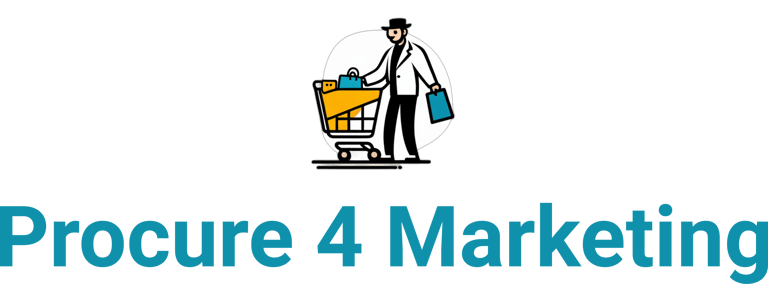How to Identify Potential Suppliers and Agencies
A 5-step guide on how to find and identify the right marketing suppliers and agencies for your business, from defining your needs to negotiating a contract.
MARKETING PROCUREMENT
The Procure 4 Marketing Team
9/4/20233 min read


Quick Answer: How do you find marketing suppliers and agencies?
Finding the right marketing partner is a strategic process that involves 5 key steps: 1) Clearly Defining Your Needs by creating a detailed brief, 2) Conducting Research to create a "longlist" of potential partners, 3) Issuing an RFP to narrow the field to a "shortlist," 4) Deeply Evaluating the Shortlist by checking portfolios and references, and 5) Selecting the Winner and negotiating a final contract. This structured approach ensures you choose a partner that delivers the best value, not just the lowest price.
First, What's the Difference Between a Supplier and an Agency?
Before starting your search, it's important to understand the distinction between a supplier and an agency in a marketing context.
1- Suppliers:
Role: Provide the tangible goods or specific tools needed for marketing.
Examples: Printing companies (for brochures), promotional merchandise vendors, email marketing software providers (e.g., Mailchimp).
2- Agencies:
Role: Provide strategic and creative services.
Examples: They are the experts who execute marketing campaigns.Creative ad agencies, digital marketing agencies (for SEO/PPC), public relations (PR) firms, event management companies.
This guide will help you find the right partner, whether it's a supplier for goods or an agency for services.
A 5-Step Guide to Finding the Perfect Partner
Let's walk through the 5 key steps using a simple, consistent example: a company looking for a video production agency to create a new brand video.
Step 1: Clearly Define Your Needs (Create a Brief)
You can't find the right partner if you don't know what you're looking for. The first step is to create a detailed internal document, often called a creative brief or a statement of requirements.
Example: The marketing team creates a brief specifying their need for a 2-minute brand video. The brief outlines the target audience (young professionals), the key message (innovation and sustainability), the required deliverables (one hero video, three shorter social media cut-downs), the budget ($50,000), and the deadline (to be completed in Q4).
Step 2: Conduct Research and Create a "Longlist"
Once you know what you need, start researching potential partners to create an initial "longlist" of candidates.
Key Research Methods:
Use Your Network: Ask colleagues and industry peers for recommendations.
Explore Online: Use LinkedIn, industry-specific directories, and search engines to find agencies. Look at their websites and recent work.
Attend Industry Events: Trade shows and conferences are excellent places to meet potential partners.
Example: The team uses these methods to create a longlist of 10 promising video production agencies that appear to have the right creative style and experience.
Step 3: Issue an RFP to Create a "Shortlist"
To formally compare your longlisted candidates, you send them a Request for Proposal (RFP). This document contains your brief and asks the agencies to submit a proposal detailing their creative approach, team, timeline, and detailed costs.
Example: The team sends the RFP to the 10 agencies. Based on the quality of the creative ideas and the proposed budgets in the proposals they receive, they narrow the field to a shortlist of the top 3 agencies.
Step 4: Deeply Evaluate the Shortlist
This is where you conduct your due diligence on the final contenders. This involves more than just reading their proposal.
Key Evaluation Actions:
Review Portfolios in Detail: Look at their past work. Is it high quality? Have they done similar projects?
Check References: Call their past clients and ask about their experience. Were they on time? On budget? Collaborative?
Meet the Team: Hold a "pitch" meeting (in person or virtual) to meet the actual team who would be working on your project. Is there a good cultural fit and a strong creative connection?
Example: The team holds pitch meetings with the 3 shortlisted agencies, reviews their showreels, and calls two references for each agency.
Step 5: Select the Winner and Negotiate the Contract
After evaluating the shortlist, you select the winning partner. The final step is to negotiate a contract and a detailed Scope of Work (SOW) that clearly outlines all deliverables, timelines, and payment terms.
Example: The team selects the agency that had the most compelling creative idea and a strong, collaborative team. The procurement department then negotiates the final contract, and the project kicks off.
Frequently Asked Questions (FAQ)
Q1: What is an RFI (Request for Information) and how is it different from an RFP?
An RFI is a less formal document used before an RFP when you have a very long list of potential suppliers. Its goal is to gather general information to help you create a more qualified longlist. An RFP is a more formal and detailed request sent to a shorter list of vendors to get a specific proposal for a specific project.
Q2: What are the biggest mistakes to avoid when choosing an agency?
Two of the biggest mistakes are: 1) Focusing only on the lowest price instead of the best overall value (creativity, quality, and service), and 2) Not checking references, which can lead to partnering with an agency that has a history of missing deadlines or being difficult to work with.
Q3: Does this process work for smaller purchases?
For smaller, less critical purchases (e.g., buying standard promotional pens), a full 5-step process is not necessary. A simplified process of getting 2-3 quotes from pre-approved suppliers is often sufficient. This detailed process is best reserved for strategic, high-value, or high-risk sourcing projects.

